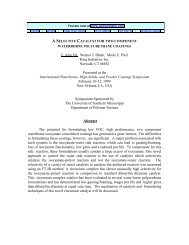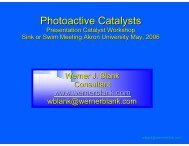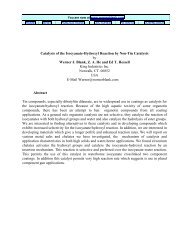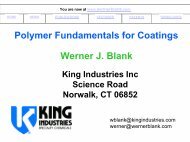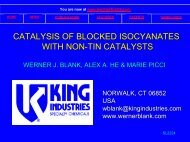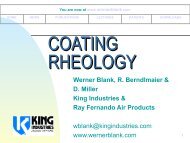Catalysis of the Epoxy-Carboxyl Reaction - Werner Blank
Catalysis of the Epoxy-Carboxyl Reaction - Werner Blank
Catalysis of the Epoxy-Carboxyl Reaction - Werner Blank
Create successful ePaper yourself
Turn your PDF publications into a flip-book with our unique Google optimized e-Paper software.
Table 3. continued<br />
Cure Conditions 140°C, 15 min<br />
Catalyst MEK double rubs Viscosity<br />
0 hours, cps<br />
paper23.doc Printed 4/20/2003<br />
Viscosity<br />
6 weeks, cps<br />
Ti ethyl acetoacetate chelate 50 340 Gelled<br />
Ti acetylacetonate chelate 72 300 Gelled<br />
Ti triethanolamine chelate -- Gelled --<br />
Zinc acetate >200 210 Gelled<br />
Zinc acetylacetonate 197 270 570<br />
Zinc di-2-ethylhexyldithio-phosphate 35 280 Gelled<br />
Zinc nitrate 84 290 680<br />
Zinc octoate 95 325 540<br />
Zirconium 6-methylhexanedione 138 295 590<br />
Zirconium Octoate -- gelled --<br />
Zirconium(IV) trifluoroacetylacetone 72 120 145<br />
To fur<strong>the</strong>r elucidate <strong>the</strong> effect <strong>of</strong> <strong>the</strong> zinc counterions on solubility and interaction<br />
with <strong>the</strong> carboxyl groups <strong>of</strong> <strong>the</strong> acrylic resin, a number <strong>of</strong> zinc salts <strong>of</strong> different acids<br />
were prepared. The test solution was prepared with <strong>the</strong> commercially available acrylic<br />
resin with a carboxyl equivalent weight <strong>of</strong> 748. Fifty parts by weight <strong>of</strong> this resin were<br />
dissolved in 50 parts by weight <strong>of</strong> 2-methoxypropyl acetate and <strong>the</strong> catalyst was dissolved<br />
in 3.5 parts by weight <strong>of</strong> methanol. A concentration <strong>of</strong> catalyst was used which<br />
corresponded to 0.4 % <strong>of</strong> zinc based on <strong>the</strong> weight <strong>of</strong> <strong>the</strong> acrylic polymer. The viscosity<br />
<strong>of</strong> <strong>the</strong> blend was immediately measured. Exchange <strong>of</strong> <strong>the</strong> zinc salt with <strong>the</strong> <strong>Carboxyl</strong><br />
groups <strong>of</strong> <strong>the</strong> resin can lead to ionic crosslinking and to an increase in viscosity. (Eq. 22)<br />
RCO2H + Zn(R'CO2)2 ↔ (RCO2)2Zn + R'CO2H (22)<br />
We observed that <strong>the</strong> hydroxy acids and <strong>the</strong> acids with a higher pKa and showed a<br />
reduced increase in viscosity. Zinc sulfonic acid salts gave excellent stability, but poor<br />
cure response. (Table 4)<br />
Table 4. Viscosity <strong>of</strong> <strong>Carboxyl</strong> Functional Acrylic Resin in <strong>the</strong> Presence <strong>of</strong> 0.4 % Zn<br />
Counterion to zinc, acid; Viscosity, cps<br />
Octanoic no Zn added (control) 880<br />
Acetic 1480<br />
Dichloro acetic acid 1160<br />
Isobutyric acid 1440<br />
Octanoic acid 1440<br />
Maleic isobutyl half ester 1480<br />
Benzoic acid 1240<br />
2-(p-Toluoyl)benzoic acid 1520<br />
Oxalic acid 1240<br />
Ethylmalonic acid 1520<br />
o-Phthalic acid Precipitate, gel



